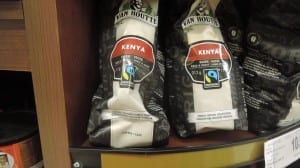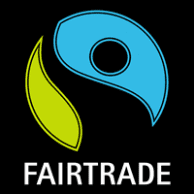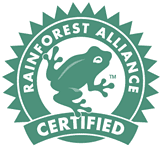Stage magic and Fair Trade coffee
By way of an introduction:
1) Truthiness refers to sense making in the absence of evidence.
2) What does the work of stage magicians tell us about how the mind works? The link to a May 3, 2008 Boston Globe article about this topic can be accessed at the previous sentence.
The article notes that our model of how perception occurs has changed in the past decade; according to the new model, “visual cognition is understood not as a camera but something more like a flashlight beam sweeping a twilit landscape. At any particular instant, we can only see detail and color in the small patch we are concentrating on. The rest we fill in through a combination of memory, prediction and a crude peripheral sight. We don’t take in our surroundings so much as actively and constantly construct them.”
The article adds:
- Our picture of the world is kind of a virtual reality,” says Ronald A. Rensink, a professor of computer science and psychology at the University of British Columbia and coauthor of a paper on magic and psychology that will be published online this week in Trends in Cognitive Sciences. “It’s a form of intelligent hallucination.”
[End of excerpt]
A 2010 article about visual perception by Ronald Rensink (see previous paragraph), entitled “Seeing Seeing,” can be accessed here.
Fair trade coffee: the brand
3) Recently I’ve been reading about fair trade coffee:
Does Fairtrade certification benefit poor farmers? In Ethiopia and Uganda, the answer is No: study
So far, through my reading and Twitter conversations, I’ve concluded that fair trade coffee as a brand is simple and evocative: “Pay a premium for your coffee thereby helping poor farmers get a fair price for their product.” Or: “Change your coffee change your world.”
I speak as a person who much enjoys the taste of coffee and the ambience at my local, independent coffee shop, Fair Grounds Organic Beanery & Café. I also enjoy visiting Birds and Beans Café by the Lake and the Second Cup at Cloverdale Mall.
Fair trade coffee: the back story
The back story related to fair trade coffee is, in turn, complicated and evocative.
Fair trade coffee, as a brand, may have an element of truthiness as a key ingredient. By way of genres, it appears to demonstrate characteristics of the borderland between fiction and non-fiction.
Truthiness is a pervasive feature of our lives, a key feature of history and prehistory. It may be a characteristic of human perception that’s wired into our brains – figuratively speaking – as a feature of evolutionary biology.
Truthiness is a feature of mental functioning that stage magicians must, of necessity – in order to excel at their craft – learn to work with closely.
It takes a little more work to access the fair trade coffee back story than it takes to access the brand.
It takes more work, in many cases, to access any back story than it takes to access the brand, the blurb, or the brief news report.
Evidence-based practice and truthiness
Evidence-based practice, and evidence-based ways of making sense of the world, are the antithesis – that is, the direct opposite – of truthiness.
In the past I wasn’t much concerned with evidence as a key variable in sense making, but about thirty years ago I was able to address a challenging situation, with the help of other people. The people who helped me were data-oriented. Being able to arrive at a satisfactory outcome, with regard to a problem I encountered, had a strong impact on my life.
Until that point, the concept of attending closely to evidence hadn’t occurred to me.
Whenever I have reason to look closely at any back story, my first concern is:
“What is the evidence? Where is it published? How do I know the evidence is valid and reliable? How was it gathered? What are the qualifications, affiliations, and competencies of the investigators? To what extent can generalizations be made on the basis of the evidence? What is the frame of reference within which the evidence has been gathered and presented? Has the research been corroborated?”
More Real: Art in the Age of Truthiness (2012)
More Real: Art in the Age of Truthiness (2012) provides a definition and an overview (pp. 34-35) of “truthiness.”
The underlying assumption in the latter study is that “we live in an age of ‘truthiness,’ a time when our understanding of truth may not be bound to empirical evidence – that is, to anything real, provable, or factual” (p. 34).
“Defined by the American Dialect Society,” the overview adds, “as ‘the quality of preferring concepts or facts one wishes to be true, rather than concepts or facts known to be true,’ the term has come to suggest our willingness to accept the plausible in place of the true.”
The above-noted overview notes that the American invasion of Iraq serves as an illustration of truthiness in the service of American foreign policy during the Bush administration. The related back story is outlined in a June 12, 2014 Atlantic article entitled: “Iraq’s Long Unraveling: As militants vow to seize Baghdad, the country is facing a crisis that has been building for years.”
An April 28, 2014 New Yorker article addressing the same theme is entitled: “What we left behind: An increasingly authoritarian leader, a return of sectarian violence, and a nation worried for its future.”
Appeal of truthiness
By way of continuing on the theme of truthiness, a June 18, 2014 Reuters article is entitled: “Least accurate online videos on blood pressure are most popular.”
A June 17, 2014 Atlantic article is entitled: “Why Audiences Hate Hard News—and Love Pretending Otherwise: Ask readers what they want, and they’ll tell you vegetables. Watch them quietly, and they’ll mostly eat candy.”
According to the article: “We prefer thoughts that come easily: Faces that are symmetrical, colors that are clear, and sentences with parallelisms. In this light, there are two problems with hard news: It’s hard and it’s new. (Parallelism!)”
An Aug. 16, 2016 Vox article is entitled: “The media vs. Donald Trump: why the press feels so free to criticize the Republican nominee.”
The article notes: “Politicians are not fully truthful. Everyone knows that. But they make a basic effort at being, as Stephen Colbert put it, truthy. The statistics they cite are usually in the neighborhood of correct. The falsehoods they offer are crafted through the careful omission of fact rather than the inclusion of falsehood. They may say things journalists know are wrong — climate change denial is a constant among Republican officeholders — but they protect themselves by wrapping their arguments in well-constructed controversy or appealing to hand-selected experts.”
[End of excerpt]
Fair Trade and a Global Commodity (2008)
I’ve begun my study of fair trade coffee – the brand and the back story – with a Toronto Public Library copy of Fair Trade and a Global Commodity (2008).
I’m not going to have time to read the book anytime soon. However, a valuable and informative online review, published by the American Sociological Association in 2010, of the book and several others can be accessed here.
The book review, which has much increased my understanding of the underlying issues and possible ways to improve the fair trade system, refers to a contradiction in fair trade coffee – namely that it operates simultaneously “in and against the market” (Barratt Brown 1993, p. 156). The article identifies the competing Rainforest Alliance as a “‘sustainable’ certification with lower social standards” (p. 294). It also describes several ongoing fair trade projects including the Community Agroecology Network (CAN). According to a footnote, “Coffee can also be ordered directly from the [Community Agroecology Network] coop in Costa Rica at this site. It may take a while to arrive, but it is very good.”
Among the questions the article asks is whether the long term goal of fair trade coffee “is simply to increase market share or to fundamentally transform international trade” (p. 294). Related concepts are also discussed, including organic production and shade production of coffee. As well, the article highlights a viewpoint that positions the current fair trade network as a neoliberal alternative to the earlier projects of the original fair trade movement.
In its conclusion, the article notes:
- There is a general sense, among participants in the fair trade system as well as among the social scientists who study it, that fair trade has reached a crossroads and some fundamental decisions must be made. This set of books helps us to see the outlines of what is at stake and what the implications of some decisions could be. But it also makes clear that too much of the work on fair trade so far has been narrowly empirically focused, and that resolution of the current dilemmas requires more theoretical and philosophical work.
[End of excerpt]
Efforts to turn neoliberalism into a useful analytic tool
A related topic that comes to mind – which I’ve addressed in a series of earlier posts – concerns efforts to turn the term “neoliberalism” into a useful analytic tool.
Absolute Value (2014)
Also of interest is a June 30, 2010 Freakonomics article entitled: “Fair Trade and the Food Movement.” We can add that Absolute Value (2014) advances the view that consumers, in a trend that runs counter to truthiness, are increasingly less susceptible to brand-focused “framing or context manipulations.”
However, the book also acknowledges that fake online reviews – a form of scamming, a variation on the theme of truthiness – remain a source of potential concern. A June 5, 2014 Globe and Mail article about fading brand loyalty – related to the proliferation of social media – similarly addresses themes that concern the impact of context and framing in the shaping of perceptions.
Updates
Recent posts about fair trade coffee at the Preserved Stories site are listed here
A Huffington Post article, downloaded July 19, 2015, is entitled: The Myth of the Ethical Shopper. We’re still trying to eliminate sweatshops and child labor by buying right. But that’s not how the world works in 2015.
Also of interest: The Rebel Sell: How the Counterculture Became Consumer Culture (2004).
A Jan. 29, 2016 CBC article is entitled: “Coffee cups: 3 months later, are they being recycled at Tim Hortons and Starbucks?”
A Feb. 10, 2016 Guardian article is entitled: “Opinion vs facts: why do celebrities so often get it wrong? Celebrities often make wildly inaccurate claims and comments to millions of people. But the workings of our minds mean we’re all prone to such behaviour.”
How neuroscience reinforces racist drug policy
By way of a further update, a June 12, 2014 Atlantic article is entitled: “How neuroscience reinforces racist drug policy.” The article underlines the strong role that framing can play, even when we’re dealing with what on first glance appears to be objective information – that is, what is typically characterized as hard data, or as solid evidence acquired by rigorous scientific means.
The subhead for the article reads: “Brain scans do not speak for themselves. The seemingly objective science of neuroimaging can be used to justify a moral argument for or against legal marijuana – to show it as a legitimate medicine, or as a danger to your health.”
I’ve discussed the role that context plays, when neuroscience research is reported, in an earlier post:
Brain Culture (2011): The metaphor of the brain as frontier
Updates
A June 18, 2016 Globe and Mail article is entitled: “Who needs the truth in this post-factual world?’
An Aug. 24, 2016 Poynter article is entitled: “The more partisan your online media diet, the less likely you are to believe fact-checkers.”
A March 2018 CBC article referring to a March 18, 2018 CBC briadcast is entitled: The science of magic: What magic has taught us about how the brain works.”




A Nov. 15, 2023 BBC article is entitled: “Magicians less prone to mental illness – study.”
An excerpt reads:
He said that what also distinguishes magicians from many other creatives is that they “not only create their own magic tricks but also perform them, while most creative groups are either creators or performers”.
“For example, poets, writers, composers and choreographers create something that will be consumed or performed by others. In contrast, actors, musicians and dancers perform and interpret the creation of others,” he said.
“Magicians, like comedians and singer-songwriters, are one of those rare groups that do both.
“Magicians scored low on impulsive nonconformity, a trait that is associated with anti-social behaviour and lower self-control.
“These traits are valuable for many creative groups such as writers, poets and comedians whose creative acts are often edgy and challenge conventional wisdom.”
Regarding “truthiness” it has been noted is similar to the word “post-truth”:
Oxford Languages Word of the Year 2016
An excerpt at the above-noted link reads:
After much discussion, debate, and research, the Oxford Dictionaries Word of the Year 2016 is… post-truth.
Post-truth is an adjective defined as ‘relating to or denoting circumstances in which objective facts are less influential in shaping public opinion than appeals to emotion and personal belief’.